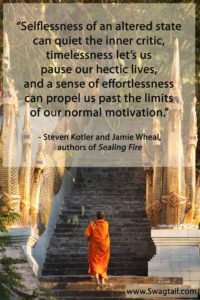Teaching yoga can be a fulfilling way to share your gifts as a part-time or full-time venture. Yet the recent change to teaching classes online and uncertainty of the general business climate might have you feeling discouraged or disconnected. That’s why it’s essential you manage your energy well in challenging times. It’s important you find your own flow to remain motivated and stay the course of your life. This post shows you simple ways to stay energized today!
Getting on your yoga mat to do a practice yourself does this. Doing other activities that you love does, too.
In fact, right now I’m camping my way through Western Montana and Northern Idaho. My daily activities include stand-up paddle sessions on the lake, hiking with Kai, cooking by campfire, and restoring the body with yin yoga after long drives.
This time away from my regular routine keeps me inspired to create articles and online courses here at Swagtail. It’s in this freedom that I generate fresh ideas and get excited to teach in new ways.
My hope is that in learning more about the flow state you’ll also be able to sustain peak levels consistently–both as a yoga professional and in all other areas of your life.
FUEL YOUR FIRE
In Traditional Chinese Medicine, fire is the element from which all of life derives. It’s not only the force that provides warmth and light for man, it’s a source of joy, passion and enthusiasm. When set ablaze, it’s unstoppable. Perhaps this is why, according to Greek mythology, that Prometheus defied Zeus and gave fire to humans.
From the Eleusianian Mysteries, where Plato and Pythagorus met with other elites in secret, to Burning Man in the Nevada desert, mankind has been seeking ways to harness this power.
In no way does this indicate that real fire should be included in your yoga classes. Although the image of flame twirling while in warrior two does conjure up quite an image of empowerment. Instead, the real goal is to discover and develop practices that keep your internal fire hot.
- Can you remain motivated over a lengthy career of teaching?
- Are you able to accelerate your own levels of learning and performance?
- How do you simply, and clearly, pass these ideas on to your students?
We’ll get to that. But first, let’s understand ecstasis.
WHAT IS ECSTASIS?
Ecstasis is Greek word for stepping beyond oneself, and more broadly interpreted as the ability to engage a non-ordinary state of consciousness where there is a euphoric connection to a source of energy and intelligence far beyond normal comprehension. The book Stealing Fire, by Steven Kotler and Jamie Wheal, talk all about this in great detail.
Essentially, it’s the flow state where action and awareness merge to generate an experience far beyond our normal selves. Perhaps you’ve experienced such a profound alteration in your body and mind during a yoga class before. Or you might have tapped into that state during meditation. Maybe, it’s the high that keeps you coming back for more.
HOW DOES THE FLOW STATE WORK?
During an ecstatic experience, all of the pleasure chemicals get released into the body.
Step 1: The brain release norepinephrine and dopamine.
This increases heart rate, improves focus, and enhances the ability to link incoming information together in useful and unique ways.
Step 2: Brainwaves downshift from beta to alpha.
It’s like daydreaming mode kicks in, and any resistance to a wide array of ideas disappears.
Step 3: Hypofrontality begins.
This is a fancy way of saying that the prefrontal cortex – the part of the brain responsible for defining our sense of self – shuts down. The inner critic vanishes. Our sense of past and future dampens. Even previous filters set up to sort incoming data go away, so new information can be received more objectively.
Step 4: Endorphins and anandamide are released by the brain.
Not only do these chemicals deepen feelings of trust and intimacy, they boost the ability to connect seemingly different ideas. (By the way, this is often the way breakthroughs in any field are made).
Step 5: Theta brain ways become evident.
This is where relaxation and intuition enter the picture.
Step 6: Serotonin and oxytocin get released.
The icing on the cake comes with the feelings of peace, well-being, and sociability, thanks to the inner chemistry change.
The end result of these steps?
- A 200 percent boost in creativity.
- A 490 percent boost in learning.
- A 500 percent boost in productivity.
Now, who doesn’t want that?
HOW DO YOU KNOW IF YOU ARE IN A FLOW STATE?
According to Kotler and Wheal, there are four elements that distinctly characterize ecstasis. They call them STER.
S = Selflessness
This is all about seeing the world beyond your body, current roles, relationships, and circumstances. It’s a shift from only experiencing onself in a challenging pose on the mat, to objectively viewing that pose as a means by which you are a little less attached to the uncomfortable things in life. In time, you exit the posture and the circumstances change, and you’ll be all the wiser for the experience.
T = Timelessness
When in the flow, time feels expansive. Even though you may be processing more information, the moment seems to last longer, and it’s in that elongated “now” that you can be aware of yourself, your destination, and any correctional steps you may want to take on the journey. It’s why 10 minutes in savasana can seem to pass in the blink of an eye.
E = Effortlessness
When something feels awesome, you want to do it again. It’s why you and your students want to continue their practice. There might be moments of intensity, but making it through pose after pose, class after class, confidence is established. There’s a keen sense of enjoyment in the process that arises, and the notion that you are in control keeps you coming back for more.
R = Richness
Because of the cascade of biochemicals in the body, non-ordinary experiences are vivid and detailed. The novelty of ecstasis is that you’re tapping into the intelligence behind, and flowing through, the entire Universe. In fact, it’s been there all along, connecting to it feels significant.
THE FLOW STATE AND TEACHING YOGA
Stealing Fire covers lots of ways in which one can experience ecstasis—mindfulness training, pharmacological experimentation, extreme sports, and technological stimulation.
Yoga, although briefly mentioned, can be one of the best ways to get out of your head without breaking the bank or risking death. And, you can do it almost anytime, anywhere. The ecstatic experience you had with yoga might be the reason you were drawn to not only practice, but also to teach. Keeping the fire ablaze is now the task at hand.
Here are a few tips that can continually keep passion flowing in your life (and your classes):
Tip 1: List what activities get you in the flow
Make a list of things you love to do, in addition to yoga, that generate ecstasis. Live music, sex, meditation, traveling, massages, or self-improvement workshops. What floats your boat?
Then, decide how you can incorporate these activities into your schedule on a regular basis. While it may be appropriate for a home yoga practice or meditation to fall into a daily event, other activities might only need to be done once a month or even once a year.
Consider the enthusiasm that comes from attending a weekend yoga conference? The stimulation of ideas can last for months afterward.
Once you decide how often you might want to do those ecstatic activities, get out your calendar and pencil in some dates for yourself. For the larger ticket items, you could even get a family member or friend to join you! Have fun in the planning, and the ongoing process of stealing fire.
 Tip 2: Fold ecstasy into your everyday responsibilities
Tip 2: Fold ecstasy into your everyday responsibilities
While you get a high teaching a class, or engaging in any of your other preferred activities, there are everyday tasks that still need to be done. Cleaning the studio. Organizing the books. Updating your schedule. Taking care of your family.
You can avoid the unrelatable or airy yoga stereotypes by simply using your post-yoga bliss to be fully-focused on whatever task may follow (even if it’s not as thrilling as your previous eka pada bakasana).
Tip 3: Build momentum on a deliberate path
History has shown that stealing fire does not always mean mastery of it. Instead of burning out or burning up, set some quiet time aside to reflect on how your ecstatic endeavors are really working out for you. Using our 5-Step process to cultivate awareness can be a great way to assess the response you have to your flow activities.
HOW TO BRING FLOW TO YOUR STUDENTS
Flow is more than just a style of yoga. There are lots of ways you can sprinkle ecstasis into your classes. Check out the three following ways that are both simple and profound:
Allow the Mind to get Quiet
Inform your students that it’s entirely common and totally normal for the inner critic to arise when first moving into a non-ordinary state of consciousness, or an ecstatic experience (ie, yoga). Keep in mind that hypofrontality will kick in—where the prefrontal cortex shuts down—and the critic will be silenced. Remind the class to stick with the practice and let the neurochemicals work their magic.
 Get Upside down
Get Upside down
Google has a flow training program in which extreme playground equipment for adults, including giant looping swings and gyroscopes, are used to induce ecstasis. It turns out a certain environment can trigger this state, and so can a change in gravity. While aerial yoga gets you levitating in all sorts of directions, moving yourself on your mat in non-traditional ways can get you high. Think down dog, bridge, or headstand. Allow each inversion to amplify flow state and increase your performance both on and off of the mat.
Samadhi = Enlightenment = Ecstasy
Patanjali described the eighth limb of yoga as samadhi, where the meditator transcends the self. According to the lastest scientific research, deliberate movement of the body is one of the best ways to not only improve our emotions and get into a meditative state, it can trigger ecstasy. No need to hide away in a cave or spend hours seated. You can make the most of your moves to achieve the same thing, and so do your students with each asana on the mat.
PUTTING IT TOGETHER
The flow state is equivalent to “being in the zone” or finding your sweet spot in any activity. When you tap into this state of consciousness, you perform at a high level and sustain greater energy over time. So whether you teach yoga part-time or full-time, you can increase your professional skills with the activities you do on and off of the mat. Plus, you can share this flow state with your students in simple ways as well.
Take Action Now
- Make a list of activities that you absolutely love; the ones in which you lose track of time and get totally involved in the moment. Then schedule time this week to do one of those activities.
- Order the book Stealing Fire by Steven Kotler and Jamie Wheal. It’s a page-turner that fills in the historical perspective on ecstasis, pharmacological experiments that blew people’s minds, and engineering feats that have resulted from this non-ordinary state of consciousness.
- Share your experiences with the flow state, or ecstasis, in the comments section below! We love to hear how you’re riding the positive wave of yoga in your professional and personal life alike!


